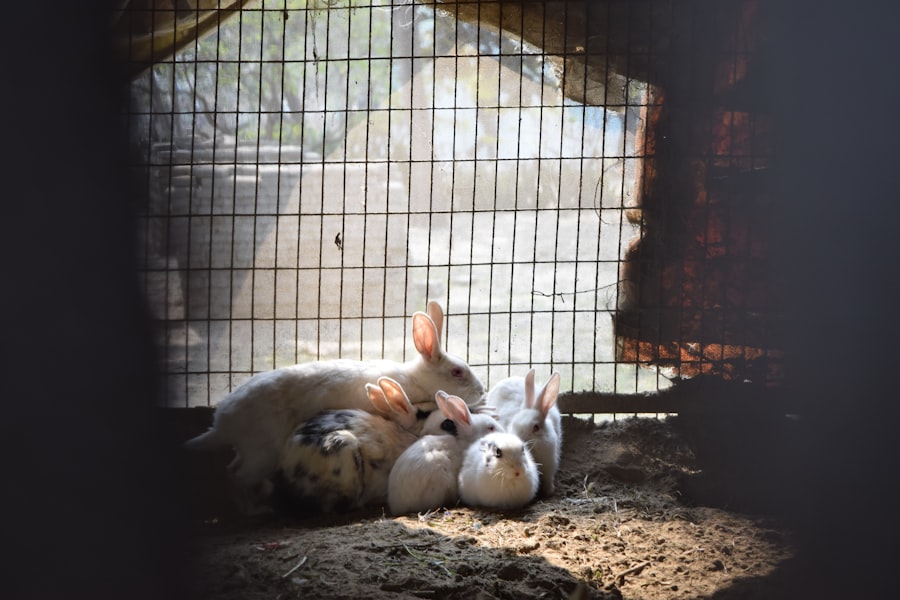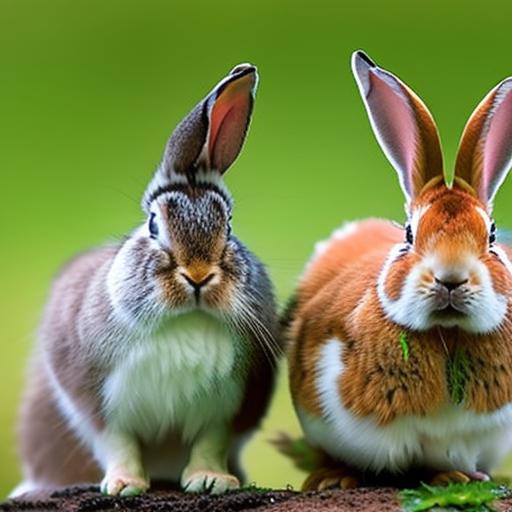Keeping bunnies and chickens together is a growing trend among pet owners and homesteaders alike. The idea of having these two adorable and productive animals coexist in harmony is appealing to many. Not only do bunnies and chickens make great companions, but they can also provide a variety of benefits when kept together. In this article, we will explore the pros and cons of keeping bunnies and chickens together, as well as provide tips on how to successfully introduce and manage these animals.
Key Takeaways
- Keeping bunnies and chickens together is a popular trend among backyard farmers.
- Pros of keeping bunnies and chickens together include pest control, manure production, and companionship. Cons include potential health risks and aggression.
- Understanding the behavior of bunnies and chickens is crucial for successful cohabitation.
- Housing requirements for bunnies and chickens should include separate areas for sleeping and nesting.
- Feeding requirements for bunnies and chickens differ, but they can share some foods.
- Health concerns when keeping bunnies and chickens together include disease transmission and parasites.
- Tips for introducing bunnies and chickens include gradual introduction and supervision.
- Managing aggression between bunnies and chickens can be done by providing enough space and resources.
- Benefits of keeping bunnies and chickens together include reduced waste and increased productivity.
- In conclusion, keeping bunnies and chickens together can be a rewarding experience with proper planning and management.
Pros and Cons
One of the main advantages of keeping bunnies and chickens together is the symbiotic relationship they can form. Bunnies are natural grazers and can help keep the grass in check, while chickens are excellent at controlling pests such as insects and slugs. By allowing these animals to share a space, you can create a more balanced ecosystem in your backyard or homestead.
Another benefit of keeping bunnies and chickens together is the potential for increased productivity. Bunnies produce nutrient-rich manure that can be used as fertilizer for your garden, while chickens provide eggs on a regular basis. By combining these two animals, you can maximize the benefits they bring to your homestead.
However, there are also potential drawbacks and challenges to consider when keeping bunnies and chickens together. One challenge is ensuring that both animals have adequate space to roam and exercise. Bunnies require ample space to hop around, while chickens need room to scratch and forage. It’s important to provide a large enough area that meets the needs of both animals.
Another challenge is managing their different dietary requirements. Bunnies are herbivores and require a diet rich in hay, fresh vegetables, and pellets, while chickens are omnivores and need a diet that includes grains, seeds, insects, and kitchen scraps. It’s crucial to provide a balanced diet for both animals to ensure their health and well-being.
Understanding Behavior
To successfully keep bunnies and chickens together, it’s important to understand their natural behavior and how they interact with each other. Bunnies are prey animals and have a strong instinct to flee from potential threats. They are generally gentle and social animals, but can become stressed if they feel threatened or overwhelmed.
Chickens, on the other hand, are flock animals and have a hierarchical social structure. They establish a pecking order within their group, which can sometimes lead to aggression and conflicts. It’s important to provide enough space and resources to minimize competition and prevent excessive aggression among the chickens.
When bunnies and chickens are introduced to each other, it’s important to do so gradually and under supervision. Bunnies may initially be wary of the chickens, while the chickens may be curious or even aggressive towards the bunnies. By allowing them to interact in a controlled environment, you can help them become familiar with each other’s presence and establish a more harmonious relationship.
Housing Requirements
Creating a safe and comfortable living space for both bunnies and chickens is essential for their well-being. Bunnies require a hutch or cage that provides enough space for them to hop around, as well as a separate area for them to hide or sleep. The hutch should be well-ventilated, secure from predators, and protected from extreme weather conditions.
Chickens, on the other hand, require a coop that provides enough space for them to roost, nest, and move around comfortably. The coop should be predator-proof, well-ventilated, and have nesting boxes for the chickens to lay their eggs. Additionally, both bunnies and chickens need access to an outdoor run or fenced area where they can exercise and graze.
When housing bunnies and chickens together, it’s important to ensure that the space is large enough to accommodate both animals’ needs. Providing separate areas within the enclosure, such as a separate hutch for the bunnies and a separate coop for the chickens, can help minimize conflicts and provide each animal with their own space.
Feeding Requirements
Meeting the dietary needs of both bunnies and chickens is crucial for their health and well-being. Bunnies require a diet that consists mainly of hay, fresh vegetables, and pellets. Hay should be available at all times to promote healthy digestion and wear down their teeth. Fresh vegetables, such as leafy greens and root vegetables, should be provided daily to ensure a balanced diet. Pellets can be given in moderation as a supplement to their hay and vegetable intake.
Chickens, on the other hand, require a diet that includes grains, seeds, insects, and kitchen scraps. A commercial chicken feed that is specifically formulated for their nutritional needs should be provided as the main component of their diet. Additionally, chickens should have access to grit, which helps them digest their food, as well as calcium supplements to support egg production.
When feeding bunnies and chickens together, it’s important to ensure that each animal has access to their specific dietary requirements. Bunnies should have their own feeding area where they can access hay and fresh vegetables without competition from the chickens. Chickens should have their own feeding area where they can access their feed and supplements without interference from the bunnies.
Health Concerns

Keeping bunnies and chickens together can pose certain health risks that need to be addressed. One potential risk is the transmission of diseases between the two animals. Bunnies can carry parasites such as fleas or mites, which can be transmitted to the chickens. Similarly, chickens can carry diseases such as avian influenza or coccidiosis, which can be transmitted to the bunnies.
To prevent the spread of diseases, it’s important to practice good hygiene and regularly clean and disinfect the housing areas of both animals. Additionally, it’s crucial to provide regular veterinary care for both bunnies and chickens, including vaccinations and parasite prevention.
Common health issues that can affect bunnies include dental problems, gastrointestinal stasis, and respiratory infections. Regular veterinary check-ups and a balanced diet can help prevent these issues. Chickens are prone to diseases such as respiratory infections, mites or lice infestations, and egg-laying problems. Regular health checks and proper husbandry practices can help prevent these issues.
Tips for Introducing
Introducing bunnies and chickens to each other should be done gradually and under supervision to ensure their safety and well-being. Start by allowing them to see each other through a wire mesh or fence, so they can become familiar with each other’s presence without direct contact. This will help reduce any initial fear or aggression.
Once they are comfortable with each other’s presence, you can allow them to interact in a controlled environment. This can be done by placing the bunnies in a secure enclosure within the chicken run or coop, or by allowing the chickens to free-range while supervised. Observe their behavior closely during these interactions and intervene if any aggression or stress is observed.
It’s important to provide plenty of hiding spots and escape routes for the bunnies, such as tunnels or boxes, so they can retreat if they feel threatened. Additionally, providing separate feeding areas for each animal can help minimize competition and reduce the risk of aggression.
Managing Aggression
Aggression between bunnies and chickens can occur, especially during the initial introduction phase or if resources are limited. To manage aggression, it’s important to provide enough space and resources for both animals. This includes providing separate feeding areas, nesting boxes, and hiding spots.
If aggression does occur, it’s important to intervene and separate the animals if necessary. This can be done by placing a physical barrier between them or by removing one of the animals from the shared space temporarily. It’s important to address the underlying cause of the aggression, such as resource competition or territorial disputes, and make adjustments to prevent future conflicts.
Benefits
Keeping bunnies and chickens together can provide a variety of benefits for both animals and their owners. Bunnies can help control the grass and provide nutrient-rich manure for the garden, while chickens can control pests and provide a regular supply of eggs. By combining these two animals, you can create a more self-sustaining and productive environment.
Additionally, bunnies and chickens can complement each other in terms of their behavior and social needs. Bunnies are social animals that enjoy the company of others, while chickens thrive in a flock environment. By providing them with companionship, you can help fulfill their social needs and improve their overall well-being.
Furthermore, keeping bunnies and chickens together can be a rewarding experience for pet owners and homesteaders alike. It allows for a more diverse and interactive environment, where different species can coexist and interact with each other. It also provides an opportunity to teach children about responsible pet ownership and sustainable living practices.
Keeping bunnies and chickens together can be a rewarding and beneficial experience for both animals and their owners. By understanding their behavior, providing appropriate housing and feeding requirements, addressing health concerns, and managing aggression, you can create a harmonious environment where these animals can coexist. Whether you’re looking to create a self-sustaining homestead or simply want to enjoy the companionship of these adorable creatures, keeping bunnies and chickens together is definitely worth considering.
If you’re considering keeping bunnies and chickens together, it’s important to understand the dynamics between these two animals. While they can coexist peacefully, there are certain factors to consider. For more information on this topic, check out this informative article on the Poultry Wizard website: The Chicken Coop Country Diner. This article provides valuable insights into creating a harmonious environment for both bunnies and chickens in your backyard. Additionally, if you’re looking for practical coop designs, you might also find these articles helpful: A-Frame Chicken Coop and Where to Put Chicken Coop.
FAQs
What are the benefits of keeping bunnies and chickens together?
Keeping bunnies and chickens together can provide mutual benefits such as companionship, pest control, and manure management. Bunnies can help keep the chicken coop clean by eating leftover feed and chicken droppings, while chickens can help control pests and provide a source of food for the bunnies.
What are the risks of keeping bunnies and chickens together?
There are several risks associated with keeping bunnies and chickens together. Chickens can peck and injure bunnies, while bunnies can scratch and injure chickens. Additionally, chickens can transmit diseases to bunnies, and vice versa. It is important to monitor their interactions and separate them if necessary.
What should be considered before keeping bunnies and chickens together?
Before keeping bunnies and chickens together, it is important to consider the size of the enclosure, the temperament of the animals, and their individual needs. The enclosure should be large enough to accommodate both species and provide adequate shelter and food. The animals should also be introduced gradually and monitored closely to ensure their safety.
What should be the diet of bunnies and chickens when kept together?
Bunnies and chickens have different dietary needs, and it is important to provide them with appropriate food. Bunnies require a diet high in fiber, such as hay and fresh vegetables, while chickens require a diet high in protein, such as chicken feed and insects. It is important to provide separate feeding areas to ensure that each animal receives the appropriate diet.
Can bunnies and chickens share the same nesting area?
Bunnies and chickens should not share the same nesting area. Bunnies require a separate nesting area that is quiet and dark, while chickens require a nesting area that is well-ventilated and provides easy access to their eggs. It is important to provide separate nesting areas to ensure the safety and comfort of both species.
Meet Walter, the feathered-friend fanatic of Florida! Nestled in the sunshine state, Walter struts through life with his feathered companions, clucking his way to happiness. With a coop that’s fancier than a five-star hotel, he’s the Don Juan of the chicken world. When he’s not teaching his hens to do the cha-cha, you’ll find him in a heated debate with his prized rooster, Sir Clucks-a-Lot. Walter’s poultry passion is no yolk; he’s the sunny-side-up guy you never knew you needed in your flock of friends!







